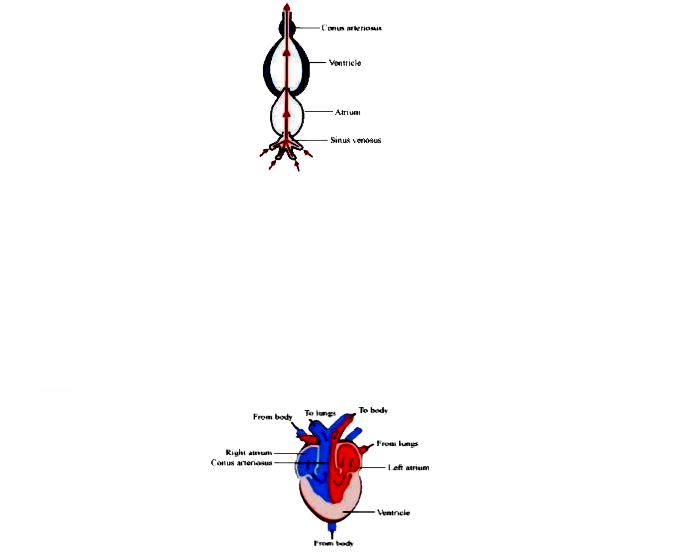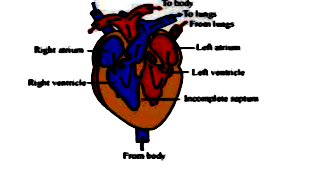Describe the evolutionary change in the pattern of heart among the vertebrates.
Video Solution
Text Solution
All vertebrates possess a heart – a hollow muscular organ composed of cardiac muscle fibres. The function of the heart is to pump oxygen to all parts of the body. The evolution of the heart is based on the separation of oxygenated blood from deoxygenated blood for efficient oxygen transport.
In fishes, the heart was like a hollow tube. This evolved into the four-chambered heart in mammals
Piscean heart Fish has only two chambers in its heart – one auricle and one ventricle. Since both the auricle and the ventricle remain undivided, only deoxygenated blood passes through it. The deoxygenated blood enters the gills for oxygenation from the ventricle. It has additional chambers such as sinus venosus and conus arteriosus.

Amphibian heart
Amphibians, such as frogs, have three-chambered hearts, with two auricles and one ventricle. The auricle is divided into a right and a left chamber by an inter-auricular septum, while the ventricle remains undivided.
Additional chambers such as sinus venosus and conus arteriosus are also present. The oxygenated blood from the lungs enters the left auricle and simultaneously, the deoxygenated blood from the body enters the right auricle. Both these auricles empty into the ventricle, wherein the oxygenated and deoxygenated blood get mixed to some extent.

Reptilian heart
Reptiles have incomplete four-chambered hearts, except for crocodiles, alligators, and gharials. They have only one accessory chamber called sinus venosus. The reptilian heart also shows mixed blood circulation.

Avian and mammalian hearts
They have two pairs of chambers for separating oxygenated and deoxygenated bloods. The heart is divided into four chambers. The upper two chambers are called atria and the lower two chambers are called ventricles. The chambers are separated by a muscular wall that prevents the mixing of the blood rich in oxygen with the blood rich in carbon dioxide.

|
Updated on:21/07/2023
Topper's Solved these Questions
Similar Questions
Knowledge Check
- Question 1 - Select One
A change of heart
ATo have a second opinionBTo have a heart transplantCTo fail to fulfill a promiseDA change in one's opinion - Question 2 - Select One
The greatest evolutionary change enabling the land vertebrates to be completely free from water , was the development of
AFour appendagesBLungsCShelled eggs and internal fertilizationDFour chambered heart - Question 3 - Select One
Heart can be three or four chambered in the vertebrate group
AFishesBSalamanderCReptiliaDBirds
Describe the conducting system of human heart.
View SolutionThe greatest evolutionary change enabling the land vertebrates to be completely free from water habitat is the development of
View SolutionThe greatest evolutionary change enabling the land vertebrates to be completely free from water, was the development of
View SolutionThe greatest evolutionary change enabling the land vertebrates to be completely free from water , was the development of
View SolutionThe key difference between evolutionary and cultural change is that evolutionary change alters _____ whereas cultural change _____ alters.
View Solution

